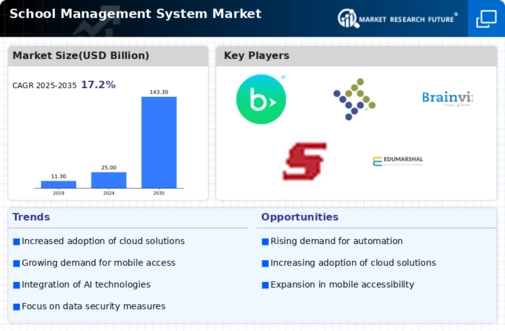Top Industry Leaders in the School Management System Market

Competitive Landscape of the School Management System Market: A Comprehensive Analysis
The global school management system (SMS) market is experiencing a thrilling surge, propelled by the relentless march of digitization in education. This burgeoning landscape is teeming with established players, emerging challengers, and a dynamic interplay of strategies that shape the battle for market share.
Key Players:
-
Unit4
-
Black baud
-
Tyler Technologies
-
Brainvire
-
Sparkrock
-
Edumarshal
-
Serosoft
-
Focus Softnet
-
SAP
-
Prolitus
-
Sage
-
TCS
-
Illuminate education Corp.
-
Campus Management Corp.
Strategic Maneuvers for Market Domination:
The fight for market share in the SMS arena is intense, with players adopting diverse strategies to gain an edge. Some key tactics include:
-
Product Differentiation: Players are constantly innovating, adding new features and modules to their solutions. Integration with AI, advanced analytics, and learning management systems are prominent trends.
-
Cloud-Based Deployment: Recognizing the shift towards cloud adoption, players are increasingly offering cloud-based solutions, enabling flexibility and scalability.
-
Regional Expansion: Established players are venturing into new markets, particularly in the Asia Pacific region, which boasts the fastest growth potential.
-
Mergers and Acquisitions: Consolidation is a key trend, with larger players acquiring smaller companies to expand their product portfolio and geographic reach.
-
Partnership Strategies: Collaborations with other education technology providers are common, offering customers a more comprehensive ecosystem.
Factors Shaping Market Share Analysis:
While established players hold significant sway, it's crucial to consider factors that influence market share dynamics:
-
Target Market Focus: Some players specialize in K-12 solutions, while others cater to higher education. Understanding the specific needs of each segment is crucial.
-
Pricing Strategy: Cost-effective solutions often find favor in price-sensitive emerging markets, while feature-rich premium offerings cater to institutions with larger budgets.
-
Local Language Support: The ability to offer solutions in local languages can be a significant advantage in specific regions.
-
Compliance with Regulations: Data security and privacy compliance are paramount concerns for schools, and players offering robust solutions in this area have an edge.
Rise of the Challengers:
Alongside established players, a new wave of innovative companies is disrupting the market. These emerging companies are characterized by:
-
Agile Development: They are quick to adapt to changing market trends and incorporate new technologies.
-
Niche-Specific Solutions: They cater to specific pain points or functionalities, offering specialized solutions compared to broader offerings of established players.
-
Cloud-Native Architecture: They leverage cloud-based technologies from the ground up, offering superior scalability and accessibility.
-
Subscription-Based Pricing: They often adopt flexible subscription models, making their solutions more accessible to smaller institutions.
Investing in the Future:
Current investment trends reveal a focus on several key areas:
-
Artificial Intelligence (AI): Integrating AI for personalized learning, automated grading, and administrative tasks is a major area of investment.
-
Learning Management Systems (LMS): Integrating SMS with LMS platforms to create a seamless learning experience is a top priority.
-
Mobile Solutions: Developing mobile apps for parents, students, and teachers to access information and engage with the system on the go.
-
Data Analytics: Leveraging data insights to improve decision-making, optimize resource allocation, and personalize learning experiences.
Latest Company Updates:
-
Microsoft launches new education platform with integrated SMS: Microsoft has launched a new education platform called "Microsoft Education Experience Platform" that includes an integrated SMS solution.
-
Google Classroom integrates with popular SMS provider: Google Classroom has announced an integration with the popular SMS provider, Skyward, allowing for seamless communication between teachers, students, and parents.
-
Cybersecurity concerns in SMS: There have been concerns about cybersecurity vulnerabilities in SMS, leading to increased demand for secure and reliable solutions.









